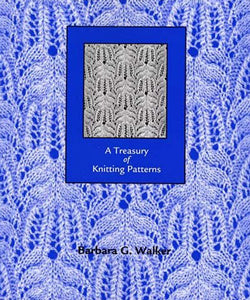I have a few go-to knitting stitch collections, among them Barbara G. Walker's four Treasury of Knitting Patterns. Barbara G. Walker wrote these in the 60s and 70s. Although there are four treasuries, the First and Second are the two really meaty reference books of the collection. The Third and Fourth include original patterns by Barbara Walker, instructions on how to knit blankets and samplers, and some very useful glossaries of symbols and abbreviations.
You can find the treasuries on Amazon, or your local library. All four treasuries are also available directly from Schoolhouse Press, individually or as a set of four.
 A First Treasury of Knitting Patterns.
A First Treasury of Knitting Patterns.The first Walker treasury is indispensable. Chock full of over 550 basic and traditional knit-purl, mosaic, slip-stitch, eyelet, lace, and cable patterns. Great for the designer as well as the beginner knitter. Get your teeth into invaluable knitting vocabulary like "welt", "chevron", "non-curling", "eyelet" and "bias". Learn the basics of lace knitting, and why it moves the way it does. Find out about what you can do with the simple slip-stitch. Get a solid handle on how to make cables move in the right direction, and how to combine them. The first Treasury is full of beautiful, timeless patterns to add to your repertoire.
 A Second Treasury of Knitting Patterns
A Second Treasury of Knitting PatternsThe second Walker treasury is similar to the first, but Walker broadens the type of stitch included. In this treasury, you will find many more traditional patterns, but also some "unusual and exciting" ones, as Walker calls them. Many of the stitch patterns are credited to the contributor. The Second Treasury also includes a handy chapter on Borders and Edgings.
 Charted Knitting Designs: A Third Treasury of Knitting Patterns
Charted Knitting Designs: A Third Treasury of Knitting PatternsThe Third Treasury uses a different format than the previous two. You will find some new stitches here, but primarily this book shows how to combine and shape patterns. And although the title implies charts, most of the stitch patterns are written rather than charted.
 A Fourth Treasury of Knitting Patterns
A Fourth Treasury of Knitting Patterns
This Treasury includes a comprehensive Glossary of knitting symbols and abbreviations, as well as a thorough list of cable stitches. It also includes a delightful introduction by the author, "My Life in a Nutshell". The meat of the book shows how to knit samplers in garter, mosaic, lace and cable stitches. The last chapter includes a lovely selection of new charted stitch patterns.
More on the Walker Treasuries
If you want to see more images of the stitch patterns from the Walker Treasuries, or if you want to contribute your own images, check out the
Walker Treasury Project.
A little more
Barbara G. Walker was born 1930 in Philadelphia. As well as a knitting experet, Walker is a journalist, a feminist and a sceptic. She writes about feminism, spirituality, and religion.